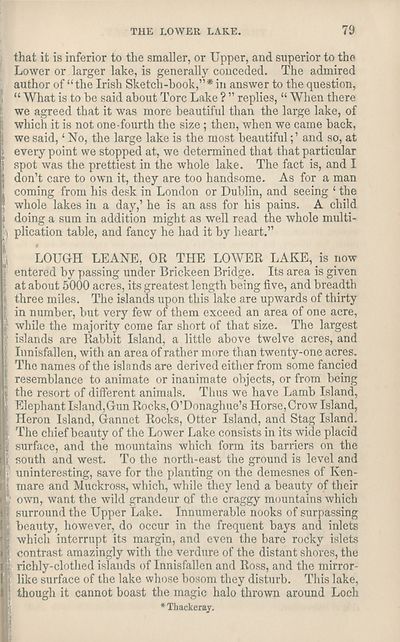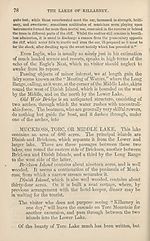Download files
Complete book:
Individual page:
Thumbnail gallery: Grid view | List view

THE LOWER LAKE.
79
that it is inferior to the smaller, or Upper, and superior to the
Lower or larger lake, is generally conceded. The admired
author of “the Irish Sketch-book,”* in answer to the question,
“ What is to be said about Tore Lake ? ” replies, “ When there
we agreed that it was more beautiful than the large lake, of
which it is not one-fourth the size ; then, when we came back,
we said, ‘ No, the large lake is the most beautifuland so, at
every point we stopped at, we determined that that particular
spot was the prettiest in the whole lake. The fact is, and I
don’t care to own it, they are too handsome. As for a man
coming from his desk in London or Dublin, and seeing ‘ the
whole lakes in a day,’ he is an ass for his pains. A child
doing a sum in addition might as well read the whole multi¬
plication table, and fancy he had it by heart.”
LOUGH LEANE, OR THE LOWER LAKE, is now
entered by passing under Brickeen Bridge. Its area is given
at about 5000 acres, its greatest length being five, and breadth
three miles. The islands upon this lake are upwards of thirty
in number, but very few of them exceed an area of one acre,
while the majority come far short of that size. The largest
islands are Rabbit Island, a little above twelve acres, and
Innisfallen, with an area of rather more than twenty-one acres.
The names of the islands are derived either from some fancied
resemblance to animate or inanimate objects, or from being
the resort of different animals. Thus we have Lamb Island,
Elephant Island,Gun Rocks, O’Donaghue’s Horse, Crow Island,
Heron Island, Gannet Rocks, Otter Island, and Stag Island.
The chief beauty of the Lower Lake consists in its wide placid
surface, and the mountains which form its barriers on the
south and west. To the north-east the ground is level and
uninteresting, save for the planting on the demesnes of Ken-
mare and Muckross, which, while they lend a beauty of their
own, want the wild grandeur of the craggy mountains which
surround the Upper Lake. Innumerable nooks of surpassing
beauty, however, do occur in the frequent bays and inlets
which interrupt its margin, and even the bare rocky islets
contrast amazingly with the verdure of the distant shores, the
richly-clothed islands of Innisfallen and Ross, and the mirror¬
like surface of the lake whose bosom they disturb. This lake,
though it cannot boast the magic halo thrown around Loch
‘Thackeray.
79
that it is inferior to the smaller, or Upper, and superior to the
Lower or larger lake, is generally conceded. The admired
author of “the Irish Sketch-book,”* in answer to the question,
“ What is to be said about Tore Lake ? ” replies, “ When there
we agreed that it was more beautiful than the large lake, of
which it is not one-fourth the size ; then, when we came back,
we said, ‘ No, the large lake is the most beautifuland so, at
every point we stopped at, we determined that that particular
spot was the prettiest in the whole lake. The fact is, and I
don’t care to own it, they are too handsome. As for a man
coming from his desk in London or Dublin, and seeing ‘ the
whole lakes in a day,’ he is an ass for his pains. A child
doing a sum in addition might as well read the whole multi¬
plication table, and fancy he had it by heart.”
LOUGH LEANE, OR THE LOWER LAKE, is now
entered by passing under Brickeen Bridge. Its area is given
at about 5000 acres, its greatest length being five, and breadth
three miles. The islands upon this lake are upwards of thirty
in number, but very few of them exceed an area of one acre,
while the majority come far short of that size. The largest
islands are Rabbit Island, a little above twelve acres, and
Innisfallen, with an area of rather more than twenty-one acres.
The names of the islands are derived either from some fancied
resemblance to animate or inanimate objects, or from being
the resort of different animals. Thus we have Lamb Island,
Elephant Island,Gun Rocks, O’Donaghue’s Horse, Crow Island,
Heron Island, Gannet Rocks, Otter Island, and Stag Island.
The chief beauty of the Lower Lake consists in its wide placid
surface, and the mountains which form its barriers on the
south and west. To the north-east the ground is level and
uninteresting, save for the planting on the demesnes of Ken-
mare and Muckross, which, while they lend a beauty of their
own, want the wild grandeur of the craggy mountains which
surround the Upper Lake. Innumerable nooks of surpassing
beauty, however, do occur in the frequent bays and inlets
which interrupt its margin, and even the bare rocky islets
contrast amazingly with the verdure of the distant shores, the
richly-clothed islands of Innisfallen and Ross, and the mirror¬
like surface of the lake whose bosom they disturb. This lake,
though it cannot boast the magic halo thrown around Loch
‘Thackeray.
Set display mode to:
![]() Universal Viewer |
Universal Viewer | ![]() Mirador |
Large image | Transcription
Mirador |
Large image | Transcription
| Antiquarian books of Scotland > Ireland/Irish > Black's guide to Killarney and the south of Ireland > (91) |
|---|
| Permanent URL | https://digital.nls.uk/118861760 |
|---|
| Description | Thousands of printed books from the Antiquarian Books of Scotland collection which dates from 1641 to the 1980s. The collection consists of 14,800 books which were published in Scotland or have a Scottish connection, e.g. through the author, printer or owner. Subjects covered include sport, education, diseases, adventure, occupations, Jacobites, politics and religion. Among the 29 languages represented are English, Gaelic, Italian, French, Russian and Swedish. |
|---|

